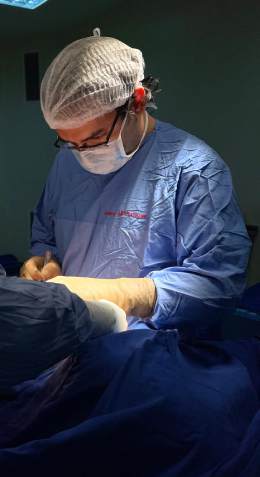Eyelid Aesthetics - Blepharoplasty
Eyelid Aesthetics - Blepharoplasty
What is Blepharoplasty?
Blepharoplasty is also known as eyelid aesthetics. It is a set of surgical procedures applied to the upper and lower eyelids, performed by a plastic surgeon to remove sagging skin and excess muscle tissue and to stretch the tissues around the eyes. The term blepharoplasty is of Greek origin; ‘blepharon’ means eyelid and ‘plastikos’ means shaping.
Why is Blepharoplasty Preferred?
People may prefer blepharoplasty for various reasons:
Aesthetic Reasons: Signs of aging of the eyelid, especially conditions such as bagging under the eyes or sagging in the upper eyelid, can cause aesthetic concerns for many people. Blepharoplasty aims to achieve a younger and more vigorous appearance by reducing these symptoms.
Opening the Visual Field: Excessive sagging of the upper eyelid can narrow the visual field of the person and create visual discomfort. Blepharoplasty provides a better visual experience by correcting this sagging.
Improving Eyelid Function: Excessive drooping or laxity can make it difficult for the eyelids to perform their normal function. This can lead to functional problems such as dry eyes.
Blepharoplasty can improve comfort by correcting these functional problems.
Does Eyelid Aesthetics Provide Long-Term Results?
Blepharoplasty usually provides long-term results. A younger and more vigorous appearance of the eyelids after surgery is usually permanent. However, as the aging process continues, the skin around the eyes may loosen again. However, the results can be maintained for a long time with regular skin care and anti-ageing treatments.
Things to Consider After Eyelid Aesthetics
Some important points to be considered after blepharoplasty are as follows:
Rest and Recovery: Take time for rest and recovery after surgery. Avoid strenuous activities such as keeping your eyes closed or watching television.
Cold Application: You can use ice packs or cold compresses to reduce swelling after surgery. However, avoid direct contact of the ice pack with the eyelids.
Use of Eye Drops: Use eye drops recommended by your doctor regularly to keep your eyes moist. Glasses and Lens Use: Avoid wearing glasses or contact lenses for a while after surgery, do not make any changes without your doctor's approval.
Smoking and Alcohol: Smoking and drinking alcohol during the postoperative recovery process can affect blood circulation and delay healing, so avoid these substances.
How is eyelid aesthetics (blepharoplasty) performed?
Eyelid aesthetics or blepharoplasty is a surgical procedure usually performed on the lower and upper eyelids. This procedure involves removing excess skin, fat or muscle tissue on the eyelid and reshaping the tissues around the eyes. Here is how blepharoplasty is performed:
1. Patient Evaluation: First, the plastic surgeon evaluates the patient's eyelid structure and the need for surgery. Eyelid sagging, bagging and other symptoms are examined. The patient is informed about his/her health status and expectations of surgery.
2. Anaesthesia: Blepharoplasty is usually performed under local anaesthesia. In some cases, sedation or general anaesthesia may be preferred depending on the patient's preference or the surgeon's recommendation.
3. Determination of Incision Site: In the preoperative planning, the locations of the incisions where the excess skin and fat in the eyelid will be removed are determined. The incisions are usually made in the natural folds of the eyelid or under the eyelash line under the eye, so that the scars appear as little as possible.
4. Tissue Removal: The plastic surgeon makes the incisions and excess skin, fat or muscle tissue is removed as needed. In the lower eyelids, fat bags are usually removed or reshaped.
5. Tissue Reshaping: The remaining skin and muscle tissue in the eyelid is reshaped and tightened as needed to achieve the desired result.
6. Incision closure: The incisions are carefully closed and closed with fine sutures. Since the sutures used are usually dissolvable, no stitches need to be removed.
7. Cold Compresses and Bandages: After surgery, cold compresses and a light bandage can be applied. This helps reduce swelling and bruising and speeds up the healing process.
Blepharoplasty usually takes about an hour and the patient can be discharged the same day. The healing process is usually completed within a few weeks, but it may take several months for full recovery and results to be visible. Being especially careful and following the doctor's recommendations will help increase success after surgery.
From What Age Can Eyelid Aesthetics (Blepharoplasty) Be Performed?
Eyelid aesthetics or blepharoplasty can usually be performed when signs of aging become visible. However, there is no specific age limit and each individual's condition is different.
Usually candidates for blepharoplasty:
Those Showing Signs of Aging: Those who show signs of aging such as sagging, bagging, or loose skin on the eyelids may be good candidates for blepharoplasty. These symptoms usually begin to appear from the age of 35-40, but the aging process may differ from person to person.
Those with Suitable Health Status: Blepharoplasty is generally applied to healthy individuals. For those with health problems such as smoking, high blood pressure, or those with a significant disease or infection in the skin, additional evaluations may be performed before surgery.
Visual and Psychological Impact: Blepharoplasty may be considered if sagging or bagging of the eyelid affects vision or reduces self-confidence.
Although blepharoplasty is a surgical procedure that can be performed at any age, it is generally more common in people aged 35 years and older. In some cases, blepharoplasty can also be performed at younger ages for genetic reasons or post-traumatic problems.
The important thing is to evaluate the condition of the individual and determine the suitability for surgery.


